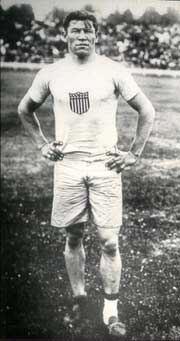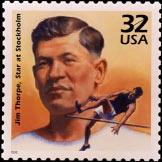 |
 |
| "JIM THORPE WAS PROBABLY THE GREATEST NATURAL ATHLETE THE WORLD HAS SEEN IN MODERN TIMES." ~ The New York Times Book of Sports Legends(1991) edited by Joseph Vecchione. |
 Jim Thorpe of the Thunder Clan of the Sac and Fox Tribe, was born May 22, 1887, on the Sac and Fox Indian Reservation, Prague, Oklahoma.
Jim Thorpe of the Thunder Clan of the Sac and Fox Tribe, was born May 22, 1887, on the Sac and Fox Indian Reservation, Prague, Oklahoma.In writing for the Fort Worth Star-Telegram, Whit Canning reported that Thorpe was the son of Hiram and Charlotte Thorpe, his Indian - name Wa-Tho-Huk - meant "Bright Path." He wrote that Thorpe had been a twin but that his brother Charlie died of pneumonia when Thorpe was 9. He also lost both of his parents when he was a teenager. In the 1912 Olympic Games in Stockholm Jim won both the pentathlon and the decathlon. When he entered the 1912 Olympic Games in Stockholm, he was probably this country's most famous college football player, enrolled at the Carlisle School, an Indian trade school in Pennsylvania. By the end of a week's Olympic activity, he had become the world's most acclaimed athlete as well." He represented the United States at the 1912 Olympic Games held in Stockholm, Sweden, even though he didn't become a citizen of the United States until 1917. Jim Thorpe founded professional football, played professional football for, and later was the first elected president of, the American Football Association (now the National Football League). The Congressional Record added that in 1913, Thorpe left amateur athletics and signed a $5,000 contract to play baseball with the New York Giants. As an outfielder with the Giants, and later with the Cincinnati Reds and Boston Braves, his best season was his last one, when he batted .327 in 60 games for Boston. In a 1950 poll by the Associated Press, Jim Thorpe was voted the greatest athlete of the half century. After he played professional ball he "knocked around, becoming an alcoholic, and drifting out of the public eye until it was discovered in the late 1940s that he was destitute. Groups throughout the country then raised thousands of dollars for him. Jim Thorpe died of a heart attack in 1953, but his memory, and his legend, live on." Ira Berkow wrote in the introduction to the New York Times Book of Sports Legends. Reporting for the New York Herald Tribune in 1953, Red Smith wrote that in the pentathlon, Jim had won the broad jump, the 200-meter hurdles, the discus throw, 1,500 meter run and was third in the javelin. In the decathlon he was first in the high hurdles, the shotput, the high jump and the 1,500. He had also been third in the 100 meters, the discus, the pole vault and the broad jump. He also placed fourth in the 400 meters and the javelin. He had come back from Stockholm with a reportedly $50,000 worth of trophies. A month after his return the Amateur Athletic Union filed charges of professionalism against him because he had played summer baseball with the Rocky Mount Club in the Eastern Carolina Leagues. Even though it had been for a small amount of money he had been stripped of his medals and his trophies sent back to Stockholm. His medals were returned posthumously on October 13, 1982. When Gerald Eskenazi wrote about the restoration of Thorpe's medal in 1982 for the New York Times he said, "Thorpe's Olympic feats and his subsequent loss of the medals gave a poignant aspect to the larger-than-life heroics that surrounded the legendary American Indian athlete's career. Not only were the medals taken away, but his triumphs were expunged from the official Olympic record books as well. Smith wrote that "He was the greatest athlete of his time, maybe the greatest of any time in any land and he needed no gilded geegaws to prove it. The proof is in the records and the memories of the men who knew him and watched him and played with him-especially those who tried to play football against him...." Smith quoted Kin Gustav of Sweden who had reportedly said to Thorpe. "Sir," said the King, heaping hardware upon him in Stockholm, "you are the greatest athlete in the world." He is the only American athlete to excel at the amateur level and at the professional level in 3 major sports--track and field, football, and baseball. He has been enshrined in the Helms Professional Football Hall of Fame and the Professional Football Hall of Fame in Canton, Ohio.  He is in the halls of fame of three sports- college football, pro footballs and track and field- and was a major league baseball player.
He lived to see the actor Burt Lancaster portray his life in a movie. And in a campaign mounted by his wife,
a town in Pennsylvania was renamed for Thorpe after his death. He is in the halls of fame of three sports- college football, pro footballs and track and field- and was a major league baseball player.
He lived to see the actor Burt Lancaster portray his life in a movie. And in a campaign mounted by his wife,
a town in Pennsylvania was renamed for Thorpe after his death.The United States Postal Service honored him with a commemorative stamp. The Jim Thorpe stamp went on sale nationwide February 3,1998. A senate resolution was put forth on May 3, 1999 to recognize Jim Thorpe as "Athlete of the Century." In the resolution it was reported that at the Carlisle Indian School in Pennsylvania, he was named All American Half-Back in 1911 and 1912. In May 1999, Congressman Paul E. Kanjorski (PA-11) and Congressman Wes Watkins of Oklahoma, a senior Republican representing Thorpe's birthplace, introduced a bipartisan resolution in the United State House of Representatives to name Jim Thorpe "America's Athlete of the Century". On Feb. 4 2000 the Yakama Nation Review reported that Jim Thorpe had been voted Athlete of the Century by ABC's Wide World of Sports. |
Read: Honoring Duke Kahanamoku with U.S. Stamp
Home | Photo Gallery | Nations/Ski Areas Mapped by State | Nations Directory | Ski Areas Directory | Events | Tributes | Snow/Earth Care
Entry Page | NA Olympic Bid | Shining Moments | Tribal Gifts | Miracles | Donations | Nations Bios | Site Credits | Site Map | Contact Us
Entry Page | NA Olympic Bid | Shining Moments | Tribal Gifts | Miracles | Donations | Nations Bios | Site Credits | Site Map | Contact Us
© Snow Riders of the American Indian Nations/ Native Voices. All Rights Reserved. This site is a world-wide collaboration.